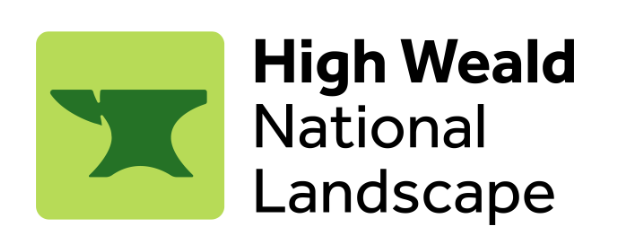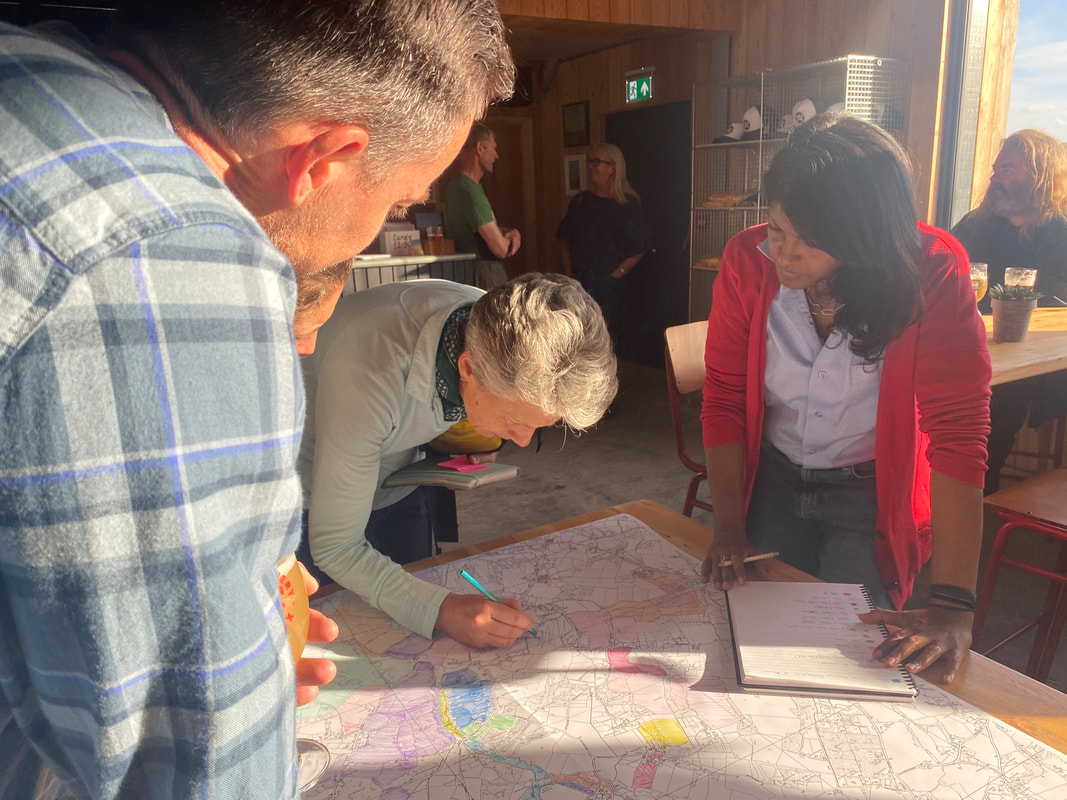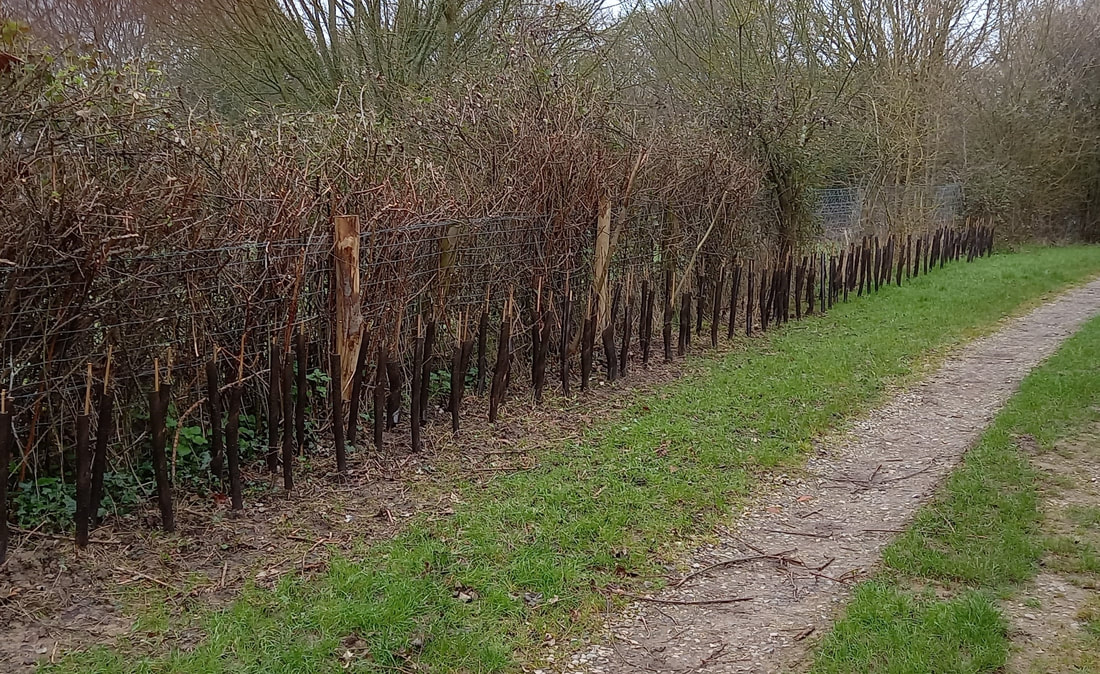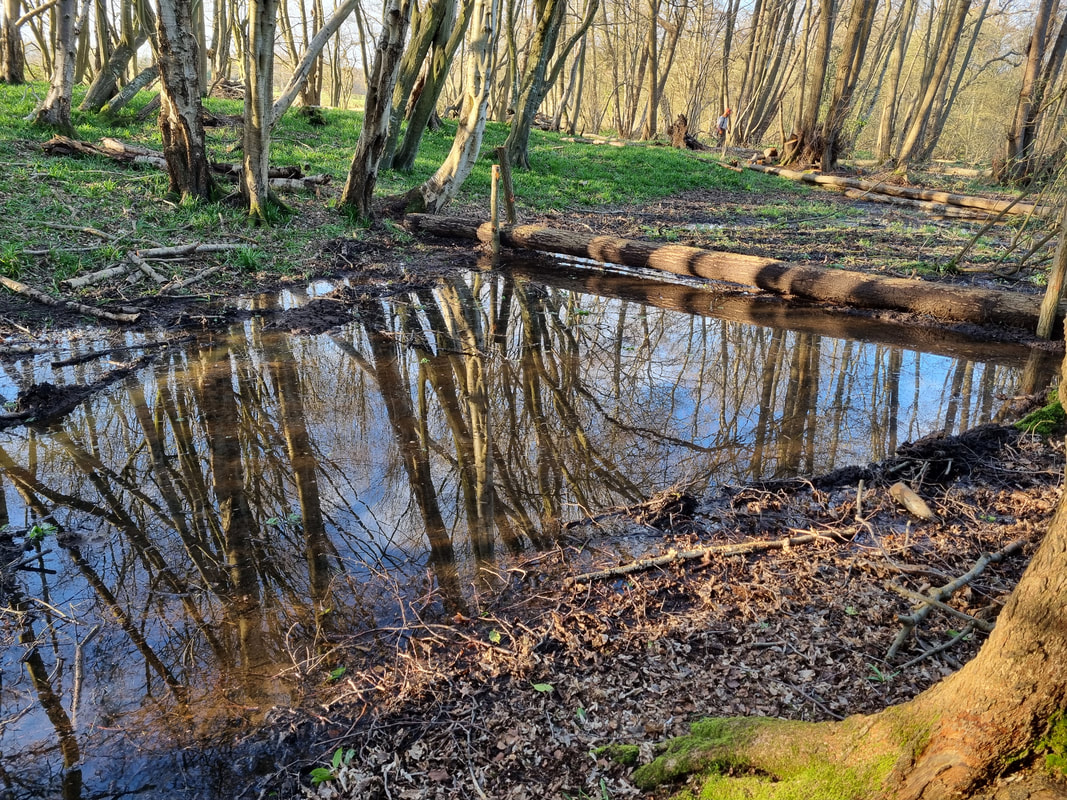Restoring natural habitats across Chiddingly Parish
Wildlife and habitats across Chiddingly Parish are under threat as a result of past landscape management decisions and future climate change. This page provides information about a series of new nature restoration projects taking place under the banner of Greening Chiddingly. The projects – all led by local farmers and landowners – have a common aim: to restore local biodiversity. They include work to restore hedgerows and woodland, plant native tree corridors along public rights of way, and reinstate areas of wetland to encourage species diversity. Farmers with land along the main stream and tributaries of the Bull River are introducing natural flood management schemes. These include building leaky woody dams to slow the movement of water from the land into our streams and reduce flood peaks downstream in the Cuckmere River. These initiatives will be enhanced by the FARMSCAPE community project, including poetry, arts and soundscapes.
|
Alongside these projects, we also want to understand the current biodiversity of the Parish, and the Bull River in particular. From April 2024, we will be using cutting-edge and pioneering science to sample the environmental DNA (or eDNA) of water at sites across the Bull River catchment. This will enable us to identify all the species living in our rivers, track biodiversity change over time, and understand the impact of our various restoration projects upon wildlife. It will also help us think about how we might support increased biodiversity within our community and the upper Cuckmere catchment.
The first phase of projects has been generously funded by the Sussex Lund, a grant programme supported by the Lund Trust and operated by the High Weald National Landscape Partnership. Support for eDNA analyses has been provided by The Chalk Cliff Trust and various private donations. This marks the beginning of an exciting journey towards a wider vision for Greening Chiddingly: to create a nature corridor, with the Cuckmere River Catchment as our guide, to restore the flow of water (and life) from the ancient oak forests of the High Weald to the critical kelp forests of the Sussex seas. Phase I of our vision is underway and work will continue throughout 2024, with further leaky woody dam building and the removal of invasive species due to take place in the summer. |
Locations of Phase I projects
|
|
Where are the projects?
Five ecological restoration projects have been funded by Sussex Lund under Phase I of our initiative. These are located on farms across the Parish, focussed on land that borders the main stream and tributaries of the Bull River.
Click on the green symbols to see what is planned on each farm. eDNA sampling points are shown in red. You can use the +/- symbols to zoom in/out. For a larger version of the map, select the [box] in the top right hand corner. Funding was also provided to support the FARMSCAPE community arts project, and for a coordinator to manage activities. |
Examples of Phase I projects
Hedgerow restoration
Over the years, many hedgerows in Chiddingly Parish have been removed as part of efforts to increase field sizes and ease access for farm machinery. Restoring these hedgerows replaces lost habitat for various bird, insect and mammal species that would have used them for food, as nesting sites, and as migration corridors. It also reinstates natural windbreaks for farmland, reducing the risk of wind erosion. The photos below show examples of hedgerow restoration in progress.
Over the years, many hedgerows in Chiddingly Parish have been removed as part of efforts to increase field sizes and ease access for farm machinery. Restoring these hedgerows replaces lost habitat for various bird, insect and mammal species that would have used them for food, as nesting sites, and as migration corridors. It also reinstates natural windbreaks for farmland, reducing the risk of wind erosion. The photos below show examples of hedgerow restoration in progress.
Woodland restoration
Woodlands are home to a range of species, from shade-loving plants and nesting birds, to fungi and rare insects. Chiddingly Parish was more densely wooded in the past, but large areas of tree cover were removed during the expansion of farmland. Many of our projects aim to restore this lost woodland, through the planting of trees at the edge of existing woodland and copses. Areas of woodland restoration are also planned along waterways and next to public rights of way.
Woodlands are home to a range of species, from shade-loving plants and nesting birds, to fungi and rare insects. Chiddingly Parish was more densely wooded in the past, but large areas of tree cover were removed during the expansion of farmland. Many of our projects aim to restore this lost woodland, through the planting of trees at the edge of existing woodland and copses. Areas of woodland restoration are also planned along waterways and next to public rights of way.
Natural flood management
Several of our projects include the creation of leaky woody dam structures across gullies and waterways. These are designed to trap sediment over time and slow the flow of water downstream. In this way, water will be held back and flood peaks reduced during periods of heavy rainfall. The areas immediately upstream of each dam also provide new pond and wetland habitats, increasing the length of the breeding season for amphibians. The photos below show the initial stages of construction of nine leaky woody dams in a wooded gully on Peke's Farm.
Several of our projects include the creation of leaky woody dam structures across gullies and waterways. These are designed to trap sediment over time and slow the flow of water downstream. In this way, water will be held back and flood peaks reduced during periods of heavy rainfall. The areas immediately upstream of each dam also provide new pond and wetland habitats, increasing the length of the breeding season for amphibians. The photos below show the initial stages of construction of nine leaky woody dams in a wooded gully on Peke's Farm.
FARMSCAPE: a multi-sensory community arts project
FARMSCAPE is a creative community project that will run alongside our habitat restoration initiatives. Using poetry, art and soundscapes, farmers and landowners will share important ecological stories about their various biodiversity projects. Our goal for the FARMSCAPE project is to help renew a sense of awe and care for Chiddingly’s rural landscapes, with benefits for residents and visitors alike. Examples of the poetry and art that might be created during the project are shown below.
FARMSCAPE is a creative community project that will run alongside our habitat restoration initiatives. Using poetry, art and soundscapes, farmers and landowners will share important ecological stories about their various biodiversity projects. Our goal for the FARMSCAPE project is to help renew a sense of awe and care for Chiddingly’s rural landscapes, with benefits for residents and visitors alike. Examples of the poetry and art that might be created during the project are shown below.
How can you get involved?
I'm a farmer or landowner
From April-July 2024, we will be focusing on Phase II projects and applying for further funding. If you are a farmer or landowner in Chiddingly Parish and have a project idea to support and restore nature on your land, then please contact us by email. We can arrange to talk to you and assess if your idea might be suitable for support from Sussex Lund.
I'm not a landowner but I'd love to help
There are other ways you can get involved. One is by volunteering. We will be looking for volunteers over the summer to help tackle the spread of invasive species including Himalayan Basalm along our waterways. If you'd like to know about volunteering opportunities, then please drop us an email.
The other way is by donating to Greening Chiddingly. We have secured the funding needed to carry out our baseline eDNA survey in 2024 and repeat monitoring in 2025, but will require support for longer-term monitoring work. If you are able to donate, no matter how small the amount, please contact us by email.
From April-July 2024, we will be focusing on Phase II projects and applying for further funding. If you are a farmer or landowner in Chiddingly Parish and have a project idea to support and restore nature on your land, then please contact us by email. We can arrange to talk to you and assess if your idea might be suitable for support from Sussex Lund.
I'm not a landowner but I'd love to help
There are other ways you can get involved. One is by volunteering. We will be looking for volunteers over the summer to help tackle the spread of invasive species including Himalayan Basalm along our waterways. If you'd like to know about volunteering opportunities, then please drop us an email.
The other way is by donating to Greening Chiddingly. We have secured the funding needed to carry out our baseline eDNA survey in 2024 and repeat monitoring in 2025, but will require support for longer-term monitoring work. If you are able to donate, no matter how small the amount, please contact us by email.
Thank you
Greening Chiddingly would like to express our immense gratitude to the Lund Trust and the High Weald National Landscape Partnership for their support and guidance in the development of these projects, and to The Chalk Cliff Trust for supporting eDNA monitoring. Thanks also to the Gun Brewery for kindly hosting various project inception and launch events. Finally, thanks to the farmers and landowners across the Parish for their enthusiasm and commitment to restoring nature at a landscape scale.



















